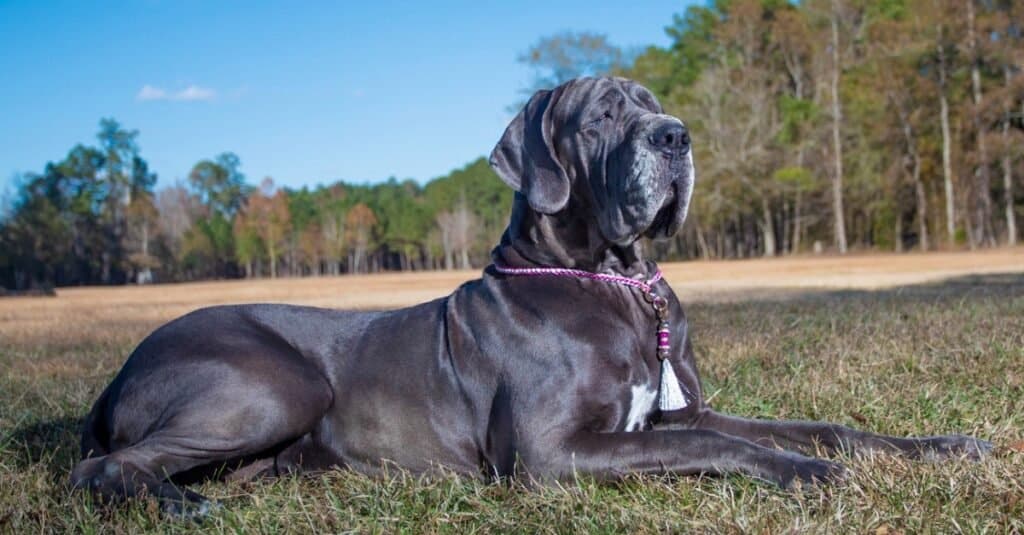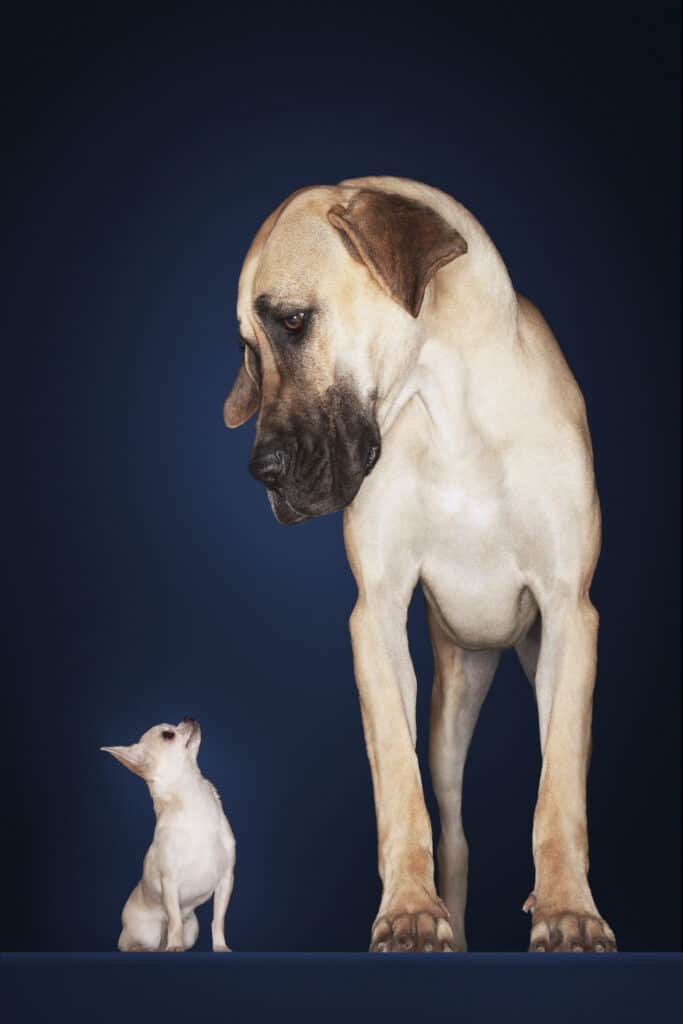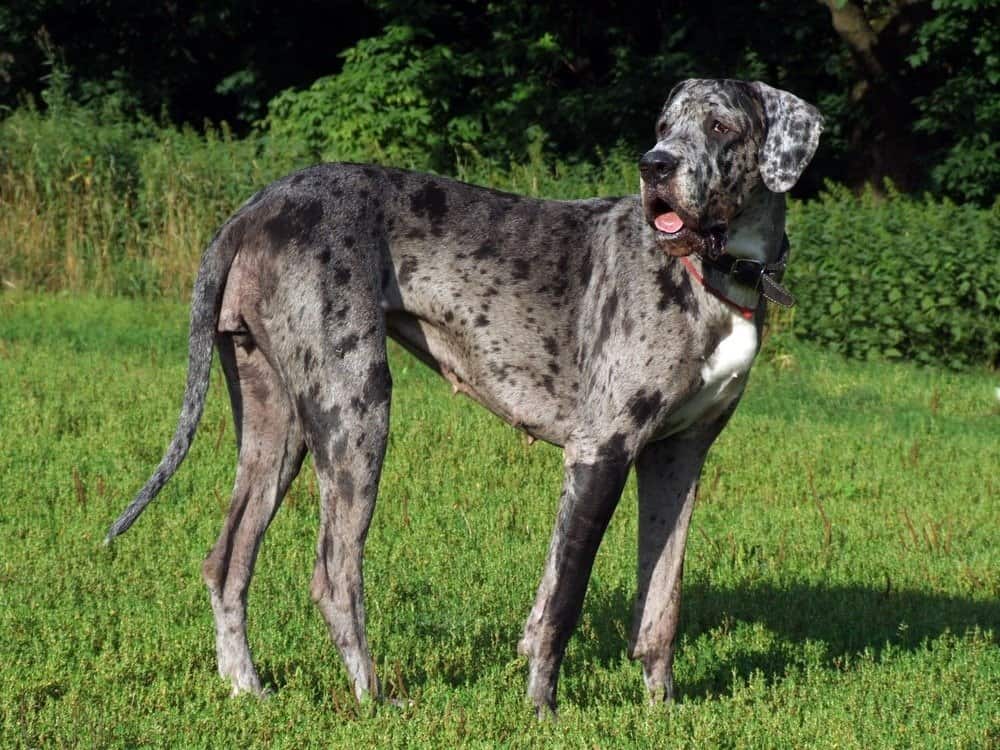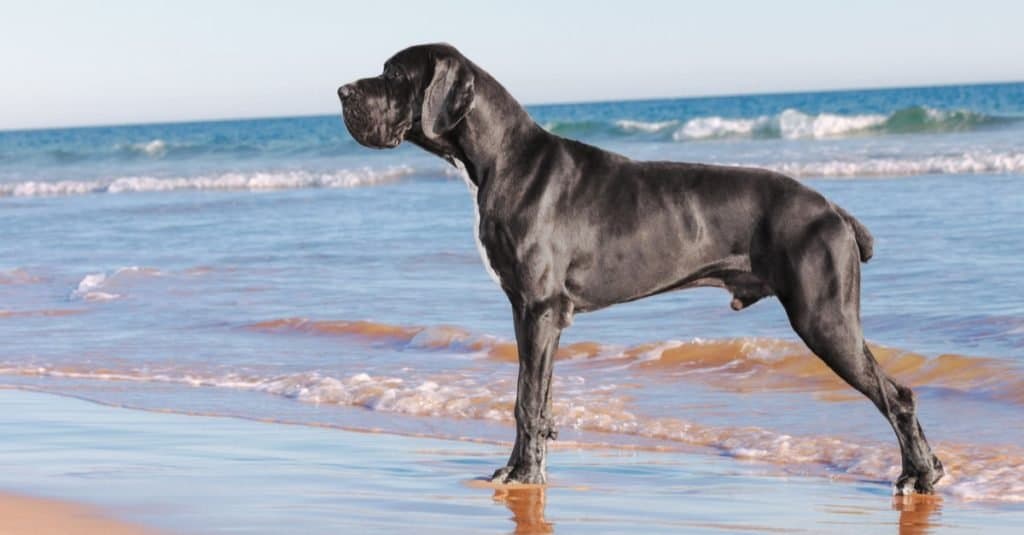Marmaduke is a comic strip about the Winslow family and their tall, messy, and hectic dog, Marmaduke. It premiered in June 1954 and ended in 2015 following the creator Brad Anderson’s death. Film studio 20th Century Fox took Marmaduke to the big screen in 2022, creating a whole new audience that fell in love with the hapless dog. He’s big and messy, but what kind of dog is Marmaduke? Let’s uncover his breed information and lots of interesting facts about this old dog breed.
What Kind of Dog Is Marmaduke?
Marmaduke is a Great Dane. It’s easy to tell from his enormous physique, drooly jowls, pointed ears, and vast appetite for food and fun.
Great Danes are a distinctive dog breed that regularly appears in pop culture. Scooby Doo is a Great Dane, as is Astro from The Jetsons. Other famous Great Dane characters include DC Comic’s Ace the Bat-Hound, and often, the hellhound features in adaptations of the Sherlock Holmes novel The Hound of the Baskervilles.
Their giant proportions make Great Danes a distinctive, sometimes intimidating, dog perfect for comics, cartoons, and film characters.

What kind of dog is Marmaduke, the beloved canine from the comic strips? A Great Dane!
©iStock.com/gsagi
Was Marmaduke a Real Dog?
Although Marmaduke is a comic strip and big-screen cartoon, his creator, Brad Anderson, owned a Great Dane called Marmalade. No doubt Marmalade provided inspiration for well-loved Marmaduke –because even the name is similar. In the past, Anderson described his many dogs, including pugs, beagles, and Chihuahuas, and how they influenced his life. Dog owners will spot real-life Marmaduke inspiration from his enthusiasm and unawareness of his enormous size.
Anderson has also stated he took inspiration from readers’ stories about their dogs, which he used in comic strips to make them not only funny but close to life.
Are Great Danes Good Pets?
Marmaduke’s antics, zest for life, and loving nature are evident in the comic strip and feature film, but is this true, and do Great Danes make good family pets?
Much like 101 Dalmatians inspired a raft of new Dalmatian owners, the Marmaduke feature film increased interest in Great Danes. Let’s find out all about this Marmaduke kind of dog.
Great Dane Breed Information
Now we know what kind of dog Marmaduke is, let’s uncover the breed.
The name Great Dane is a translation from “grand Danois,” which literally means big Danish, but Great Danes were bred in Germany, not Denmark. Originally, Great Danes were referred to as German boarhounds, but increasing tension between Germany and other European countries promoted a name change.
Boar hunting was their original function. Great Danes result from Irish wolfhounds and English mastiff parentage, which is why they are so large and powerful. When boar hunting stopped, Great Danes became a dog owned by the nobility. Nobles bred out their predator mentality and created companion animals.
Did you know the official state dog of Pennsylvania is a Great Dane? In 1965, Pennsylvanians chose it due to the breed’s strength, beauty, intelligence, and tolerance (among others) traits that exemplified Pennsylvanian folk. Pennsylvanian founder William Penn even owned a Great Dane. There’s a painting of him in the Pennsylvania Capitol’s governor’s reception room.
How Big Is a Great Dane?
Great Danes are really huge dogs; alongside Irish wolfhounds, they are one of the world’s tallest breeds.
The American Kennel Club states that before acquiring a Great Dane pup, potential owners should spend time with adult Great Danes in real life. Their eventual size is shocking to owners without previous experience with their long legs, graceful necks, and over-waist-height chunky heads.
Great Danes weigh from 110 to 175 lbs and stand up to 32 inches at the shoulder. Males tend to grow larger than females. Most Great Danes stop growing when they reach two years old. They increase in size between birth and 18 months so fast that it’s hard to fathom. However, by two years old, they’ve reached maximum size.
According to the Guinness World Records, the world’s tallest dog is Zeus, a Great Dane measuring 3 ft 5.18 inches at his withers and over seven long feet nose to tail.

Great Danes can stand up to 32 inches high and are one of the world’s tallest breeds.
©sirtravelalot/Shutterstock.com
Great Dane Temperament
Gentle giant Great Danes have sweet temperaments. They are gentle and affectionate dogs that do well with children and family pets. Despite their intimidating size and strength, Great Danes are one of the friendliest dog breeds and are easy to train.
Because they are so large, training from an early age is essential. Without training, an adult Great Dane can easily pull over their owner or behave in an unruly manner. Great Dane pups respond well to early training, which will save many problems later down the line.

Great Danes have sweet dispositions and are gentle giants.
©velora/Shutterstock.com
Great Dane Color
They have various coat colors that include plain black or fawn, plus several mixed colors:
- Brindle: fawn with various browns, black, grays, and whites
- Harlequin: white base fur with random black splotches
- Merle: grey base fur with random black splotches
- Blue: light to dark gray
- Mantle: Black base fur with a white face, chest, and feet
It’s not possible to tell a Great Dane just by its coloration; you need to factor in its size and body shape, too.
Do Great Danes Shed?
Great Danes don’t shed much because their fur is short, so it doesn’t tangle or destroy the carpet. Brushing once a week is usually enough to keep a Great Dane’s coat in tip-top shape, but during their shedding season, which is once in spring and once in fall, a daily brush manages the shed.
How Much Exercise Does a Great Dane Need?
People are surprised to hear Great Danes are not hugely active dogs. Despite their enormous size, they need a daily walk and yard access, but they don’t require hours of exercise.
Great Danes are excellent jogging and hiking companions. Adults can easily trot alongside their owners, and their vast size offers considerable safety. To avoid damaging knee joints, wait until a pup is two years old before taking them on extended hikes or jogs.

Great Danes are huge, but they don’t require hours of exercise.
©Jose Arcos Aguilar/Shutterstock.com
Do Great Danes Have Cropped Ears?
Great Danes’ cropped ears hark back to their boar hunting days because cropped ears are less likely to suffer tears or rips from a wild animal. Great Danes are born with floppy ears, and cropping is not as popular as it once was. Ear cropping is a matter of aesthetics today, and many owners decide against it.
Great Dane Health Problems
Giant Great Dane dogs are prone to several illnesses:
- Bloat: Bloat (GDV) is a potentially fatal illness caused by stomach twists and blood circulation failure. Great Danes are prone to bloat because they have such massive chests. To avoid it, wait an hour before exercise.
- Hip dysplasia: Hip dysplasia is a risk due to Great Dane’s huge size and rapid growth. It’s a condition from birth that makes the hip joint loose.
- Wobbler disease: Great Danes’ rapid growth rate pushes the vertebrae against the spinal cord and causes weakened legs.
- Cardiomyopathy: An enlarged heart that doesn’t function well is common in Great Danes.
Because Great Danes grow quickly and to such a big size, proper nutrition is essential from puppyhood. Great Danes are likely to develop growth-related health issues without balanced nutritious food.
How Long Do Great Danes Live For?
Great Danes are short-lived dogs. The average lifespan is nine years, but they can reach 12 years old with good nutrition and care.
Is Marmaduke a Great Dane Dog?
Yes, Marmaduke is a Great Dane. You can identify what kind of dog he is from his huge size, pointed ears, and jowly mouth. His sweet nature and rambunctious attitude to life are common in real-life Great Danes who enjoy every bit of life thrown at them with a friendly, goofy attitude.
Sweet-natured and great with kids, Marmaduke dogs make excellent family pets. However, potential owners must always spend time with adult Great Danes before purchasing a pup because their massive proportions may be a shock later, plus they need to know what to expect with the breed.
The photo featured at the top of this post is © iStock.com/gsagi
Ready to discover the top 10 cutest dog breeds in the entire world?
How about the fastest dogs, the largest dogs and those that are -- quite frankly -- just the kindest dogs on the planet? Each day, AZ Animals sends out lists just like this to our thousands of email subscribers. And the best part? It's FREE. Join today by entering your email below.
Thank you for reading! Have some feedback for us? Contact the AZ Animals editorial team.






